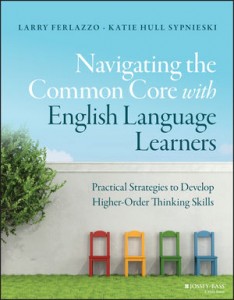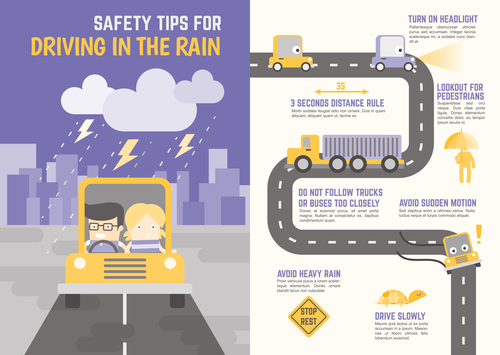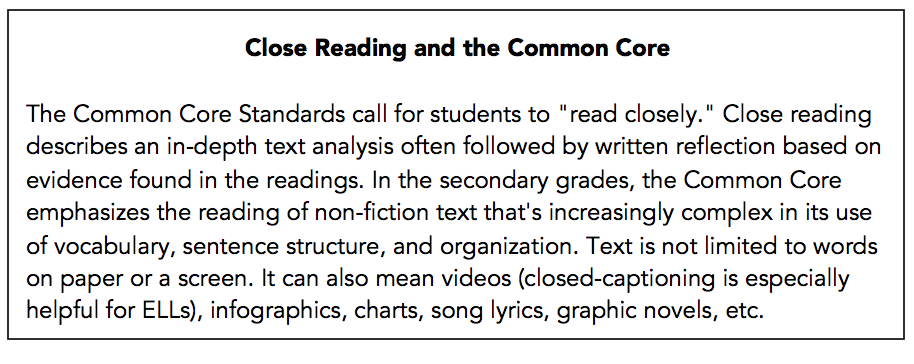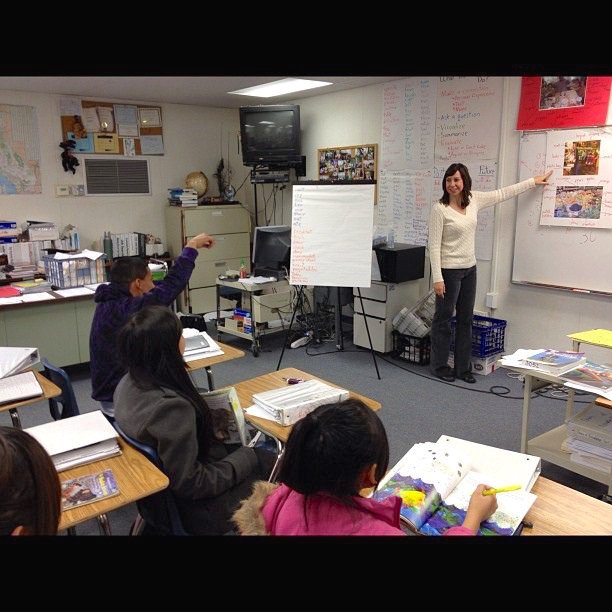Ideas for “Close Reading” with ELL Students
By Larry Ferlazzo and Katie Hull Sypnieski
In our new book Navigating the Common Core with English Language Learners, we use two analogies to help our students gain an understanding of what close reading means.
 Larry loves to play basketball. When he plays “pick-up” ball with his friends, they are loose on observing all the rules. They’ve played together a lot, know each other’s moves, and are not too picky about the quality of the court or the kind of ball they use.
Larry loves to play basketball. When he plays “pick-up” ball with his friends, they are loose on observing all the rules. They’ve played together a lot, know each other’s moves, and are not too picky about the quality of the court or the kind of ball they use.
Though they may practice some plays they’ll use in a league contest, they are generally playing for the enjoyment of the game, while at the same time wanting to improve their overall skills and build their self-confidence.
These pick-up games are the equivalent of people checking out text messages, newspapers, emails, or books they choose for pleasure reading.

They are enjoying the league play as much as their pick-up games, but at a higher level. Here they experience a sense of teamwork, the satisfaction of playing at their best and meeting the challenge of following a set of rules. They can put the moves they’ve practiced to work in a game played against an unfamiliar team.
What goes on in these league games could be the equivalent of using close reading tools and strategies to gain an understanding of complex texts.
Slow down and pay more attention
We also like the metaphor that educator and author Amy Benjamin uses. She describes close reading as “driving in bad weather, at night, on unfamiliar roads.” You feel motivated to reach your destination, but you have to slow down and use “extra tools” like high beams and windshield wipers. You minimize distractions by turning down the radio. You remember “rules” that you’ve learned, like how to turn into a skid.
Most important, you adjust your speed to fit the circumstances. It’s different from when we might be on “automatic pilot” driving around town on a summer day with few extra demands on our driving skills.
This kind of “slowing down” often means students having opportunities for what our friend Kelly Young, a highly respected educator and consultant, calls “multiple touches” on the same text with different purposes for each one. Perhaps one time it’s to analyze the central idea, another time it’s about word choice and structure, and still another it’s to find evidence in order to respond to an interpretative prompt. Often times, these “touches” include written annotation of the text in the margins or on sticky notes.
To reverse and modify an analogy suggested by psychologist Riccardo Manzotti (Parks, 2015), we can look at texts as a house with a series of locked rooms, and every time we reread the text with a specific purpose, our mind creates a key to open a different door.
These re-readings of texts, of course, must be done within reason (close reading is done with short texts to teach strategies that students can then use periodically and independently in their reading of longer ones – a class should not “close-read” an entire novel) and with engaging lessons, which we will be shortly sharing. In addition, we will be reviewing the specific scaffolding required for English Language Learners to be successful in developing the close reading skills.
 What is text complexity?
What is text complexity?
The Common Core Standards and their originators say that we must create a “staircase of text complexity” in K-12 to prepare students for college and career demands. According to the standards, “complexity” is determined by three factors:
Quantitative, which CCSS defines as an analysis of its sentence length, word use and “text cohesion,” which it says is best defined by a computer analysis. The Standards recommend specific tools to use that are free of charge where text can be copied and pasted or specific books can be searched to determine their grade-level.
Qualitative, which CCSS describes as components that educators can judge, like
• Structure: Laying out events chronologically versus sophisticated use of devices like flashbacks, graphics that are supplemental or ones that are critical for understanding, sticking to the standard conventions of a particular genre or “mixing it up.”
• Language: Is it conversational versus academic, does it include literary devices like figurative language?
• Knowledge Demands: What kind of background knowledge is required for understanding the text?
• Levels of Meaning/Purpose: Are there multiple themes and purposes or a single one? Is the purpose clear, hidden, or vague?
Reader and Task Considerations, which emphasize teacher judgment in scaffolding, purpose of the learning task, and ways to build on student motivation. In other words, matching the theory of text complexity to the reality of your classroom.
This passage from Appendix A of the standards is particularly important for teachers of English Language Learners:
Teachers who have had success using particular texts that are easier than those required for a given grade band should feel free to continue to use them so long as the general movement during a given school year is toward texts of higher levels of complexity.
It goes on to add:
…with the goal of students reading independently and proficiently within a given grade band by the end of the band’s final year. (Common Core State Standards for English Language Arts & Literacy in History/Social Studies, n.d., p. 9)

“The Three Bears Approach: Not too easy, Not too hard, Just right, but we want to make sure that as we’re finding that just right kind of sweet spot for our students that we’re always dialing it up just a tiny bit so that over the course of the year, over the course of the semester, over the course of the experience, students will be able to constantly grow in that way.”
Our interpretation of these guidelines is that we should do whatever we can to help to increase the reading proficiency of our ELL students. And our goal should be to help them reach their official grade-level by the end of the year.
At the same time, we must be realistic – a Beginner or Intermediate in secondary school is unlikely to get to that goal during their first year or two in the United States (researchers have found that it takes 4-7 years for an ELL to reach academic English proficiency). The key indicator of success is if he/she is reading increasingly complex text and applying reading comprehension strategies in more sophisticated ways.
7 things teachers should be sure to do
When we combine all the elements of the Reading strands in the Common Core Standards, then what might it mean for teachers of English Language Learners? We would suggest that it means to:
► Make sure that nonfiction text, as well as fiction, is well-represented in the reading material you use with, and is available to, your students.
► Teach students to annotate text, no matter how simple or “complex” it might be, using key reading strategies like summarizing, asking questions, and identifying the main idea. Focus on only one or two reading strategies during each rereading of the text. In addition, teach students to use metacognition to self-monitor their comprehension so they know what strategies can help them in what situations. Remember: the end-goal of close reading is to prepare students to transfer their skills to situations when you, the teacher, are not providing guidance.
► Recognize that the common teaching process of “I do, We do, You do” is probably not sufficient for English Language Learners and that additional scaffolding steps will likely be required.
► Ask text-dependent questions that require students to look for evidence in what they are reading.
► Use the common, but not text-dependent, strategy known as “text-to-self” selectively. Asking students to connect the text to their own experiences can increase student motivation, but doesn’t necessarily improve comprehension and understanding. However, if carefully constructed and monitored, text-to-self questions can provide one way to engage hesitant readers and writers as a prelude to answering more challenging text-dependent questions.
► Be strategic when spending time in prereading activities to provide background knowledge. In other words, make sure that it is a necessary tool to help students access the text, and not providing excess information and acting a substitute for what could be learned from the text itself.
► Plan to gradually increase the complexity of texts you use with students during the year. This doesn’t mean that it must be an uninterrupted incline.
An additional suggestion is that teachers should not do close reading of a text in isolation – it should be done in the context of a broader unit that includes numerous other learning activities.
Serve your vegetables in moderation
Professor Timothy Shanahan writes:
The idea is not to have students reading challenging texts exclusively. Students should have an array of reading experiences in the same way that a long-distance runner has a varied training schedule that intersperses different distances and speeds. These varied schedules enable the runner to build muscle, speed, and endurance… This means that students would, over the course of a school year (and even a school day), confront texts they could read easily with little teacher input as well as those in those upper bands specified by the standards (Shanahan, 2012-2013).

As educator Laurie Elish-Piper has said, “Close reading is like broccoli. It’s good for you, but only in moderation.”
Bonus resource: ELL Students & Reading for Pleasure
___________________

Larry Ferlazzo (@larryferlazzo) has taught English and social studies to English Language Learners and mainstream students at Luther Burbank High School in Sacramento, California, for eleven years. His widely followed blog site for educators includes many resources related to teaching ELLs in the context of the Common Core.
Katie Hull Sypnieski has worked with English Language Learners at the secondary level for twenty years and has taught English and English Language Development at Luther Burbank High School in Sacramento, California, for the last thirteen years. She is the co-author, with Larry Ferlazzo, of The ESL/ELL Teacher’s Survival Guide (Jossey-Bass, 2012). Find out more about her in this Kaplan interview.







































My experience is with adult learners trying to earn High School Equivaleny. I found Hemingway short stories to be really effective in that students really found value – and increased enjoyment – in repeated readings because they could always find new meanings.